In fall splendor or not, Minnesota's lands are fighting climate change
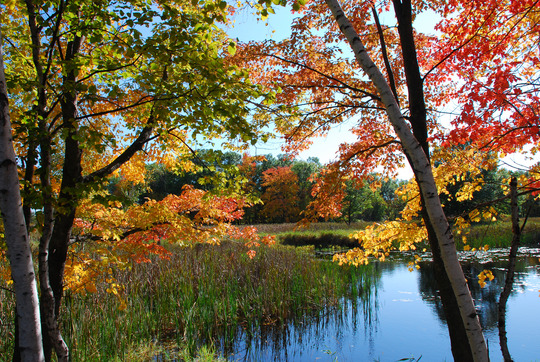
By Commissioner Sarah Strommen
The following editorial was published in the Duluth News Tribune on Sept. 21. Note: the website requires a subscription to view articles.
Leaf peeping season is beginning on the North Shore and across northern Minnesota. Over the coming weeks, thousands will head “Up North” to bask in the fall colors in the parks along iconic Highway 61 and beyond.
National Public Lands Day Saturday, Sept. 23, is a moment to pause and appreciate the astounding beauty of Minnesota’s shared spaces. Now more than ever, it’s also an important time to recognize the full value of our public lands.
From forests and grasslands to wetlands and peatlands, Minnesota’s public lands are an essential answer to climate change. Trees, grass, peat, ferns, and other vegetation are natural sponges that soak up the greenhouse gasses that warm our planet. As humans continue to create excess carbon dioxide, these critical landscapes are hard at work, absorbing and storing this pollution while releasing oxygen.
One year ago, the state of Minnesota launched a Climate Action Framework, our state’s plan to cut climate pollution, prepare for changes to come, and build a clean economy that works for all Minnesotans. One of the framework’s six goals, maintaining climate-smart natural and working lands, will help guide the Minnesota Department of Natural Resources’ continued work to harness the full power of our land as a climate solution.
In 2023, Minnesota has made big strides toward bringing our Climate Action Framework to life, including several initiatives to protect and enhance our public lands.
One of the framework’s key land-based climate solutions is preserving and growing our grasslands and wetlands. An acre of these landscapes can hold between 80 and 200 tons of carbon pollution. This year, Minnesota committed to enhancing and restoring more than 6,000 acres of these lands within our borders. This action will significantly increase our state’s carbon storage, offsetting the annual carbon emissions of more than 96,000 cars while improving wildlife habitat, enhancing water quality, and reducing flooding.
Our trees consume and deposit carbon in their roots, trunks, leaves, and branches. In 2021, forest regrowth offset more than 5% of greenhouse-gas emissions from other sectors in Minnesota. Maintaining healthy working forests, as well as adding trees in rural and urban settings, will be crucial to meeting our goal of being a carbon-neutral state by 2050. That’s why the DNR will provide to local communities more than $15 million in 2023 through our ReLeaf Community Forestry Grants program. This initiative supports local efforts to plant new trees in communities across Minnesota. We’ve also prioritized resources to collect and share native tree seedlings that will spur reforestation on public and private lands.
Perhaps the biggest underdogs in our efforts to offset climate change through smarter land use are Minnesota’s peatlands. You might know them as bogs, but peatlands hold approximately 37% of the carbon stored by Minnesota’s ecosystems, demonstrating their tremendous potential to mitigate climate pollution. However, peat also emits large quantities of carbon when it is ditched and drained. That’s why the DNR has dedicated more than $2 million this year to preserve state peatlands.
At this time of year, whether you’re hiking maple forests that give us a show on the Tettegouche Lake Loop or biking along the Root River State Trail, it’s a great time to embrace Minnesota’s vast public lands.
Just remember the next time you find the perfect tree of fiery orange leaves to post on social media or a patch of prairie where you can soak up the fading fall sun, these landscapes aren’t just beautiful, they’re powerful tools in our fight against climate change.
Complete annual required training by Dec. 31
Each year, Minnesota DNR employees must complete annual training required by the DNR, Minnesota Management and Budget, MNIT and federal and state laws. Minnesota DNR employees were enrolled in the required courses last week and are expected to complete them by Dec. 31.
All courses are online, and employees can complete them anytime through Learning Management, accessed via Self-Service. For detailed instructions and a list of the courses required, refer to the FY24 Required Training Checklist.
For more information, visit the Learning and Development intranet webpage or contact the Learning and Development unit.
Organizational Health team working to ensure thriving, vibrant workplace
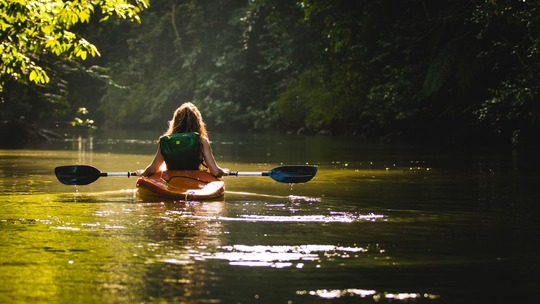
By DNR’s Organizational Health team
Today’s work environment demands a healthy and inclusive environment. The Minnesota Department of Natural Resources stands at the forefront of this idea with a dedicated Organizational Health team, which is working to ensure a thriving and vibrant workplace for all.
The purpose of the OHT is to support a workplace culture that is inclusive, respectful, and healthy. OHT strives to enhance the DNR’s ability to serve all Minnesotans by cultivating a highly qualified workforce that reflects and embraces the diversity of the state’s population and promoting department-wide coordination and cooperation. The OHT provides leadership and insight to advance the DNR’s strategic plan and priorities, specifically focusing on cultivating a supportive workspace and expanding equity, diversity, and inclusion.
“We want to continue and improve the DNR as a place where people want to work, where they can be valued for themselves, where they are supported, and where they can successfully accomplish the DNR’s mission,” Central Region Director and OHT Senior Management Team Champion Grant Wilson said.
The OHT has a unique opportunity to shape the DNR’s response to critical issues by providing advice to DNR leadership on how the organization can take action. By fostering a culture of respect, investing in employee development, and prioritizing wellbeing, the OHT plays a pivotal role in enabling the DNR to accomplish its mission more effectively and helps drive transformative changes influencing the DNR’s long-term success.
“I have found that people really want to help each other and find solutions that help support staff in their positions and at DNR,” OHT Chair Heidi Wolf said. “We work with creative, supportive, kind folks and it has been a privilege to chair this committee.”
Over the past year, OHT launched two action teams (Well-being and Diversity, Equity and Inclusion) and developed a proposal to the Senior Management Team to create formal job shadow opportunities across divisions. The team is currently leading a sub-team to develop an action plan related to findings in the 2023 Employee Engagement Survey results.
The OHT is comprised of division and regional representatives and subject matter experts to help the DNR’s future as an inclusive, supportive, and thriving workspace. Through its focus on culture, learning, and well-being, the OHT demonstrates the DNR’s commitment to its employee’s welfare and continuous improvement.
Find representative staff and learn more on the OHT webpage of the Intranet.
Write notes for the Veterans Day card drive

By the Minnesota DNR Beyond the Yellow Ribbon team
Veterans Day is fast approaching. Through the Beyond the Yellow Ribbon team Veterans Day Card Drive last year, DNR staff sent in more than 400 hand-written and heartfelt notes that were then mailed to our colleagues with military backgrounds. Since that time, even more veterans have self-identified themselves and the BTYR team would love to send them more notes of gratitude and appreciation this year. However, it can’t be done without your support.
Staff are encouraged to write a note to an anonymous service member and send it to the address below before Oct. 31. The BTYR team will then distribute your cards to the veterans who have included themselves in the military roster survey. There are nearly 200 veterans working for the Minnesota DNR, so we hope the mail room is very busy in the coming weeks.
Send your cards and notes to:
Minnesota Department of Natural Resources
ATTN: BTYR Team / Chrissy Eck
2115 Birchmont Beach Road NE
Bemidji, MN 56601
Deadline: Tuesday, Oct. 31
- Feel free to sign your name, or not. The choice is yours.
-
Please do not send gifts or gift cards. If you’ve only got a second to spare, we’re happy to relay email messages. You can send those and any other questions you have to Chrissy Eck.
Are you a veteran who hasn’t completed the military roster survey yet? There’s still time to do so. If you are connected to the military, you can voluntarily self-identify to the Beyond the Yellow Ribbon team through this short survey. The BTYR team has been so pleased with the participation in past Veterans Day card drives. A vast number of our colleagues at the Minnesota DNR would love the opportunity to show you their support through this card drive. The survey above allows the BTYR to identify who receives these greetings. For questions related to the survey, please contact Kacie Stanek.
As a Yellow Ribbon Company, the Minnesota DNR is committed to supporting and giving back to veterans in our organization. We sincerely hope you will join us in sending these individuals a bit of tangible, meaningful gratitude this Veterans Day!
Oct. 31 is the deadline for the well-being reward

Employees enrolled in the State Employee Group Insurance Program are eligible to earn $70 off their deductible the following year by reporting their activities. Oct. 31 is the deadline to earn a reduced deductible in 2024.
Review the well-being reward overview to learn more and review eligible activities and point values. Questions about eligibility, data security and data privacy are addressed in the FAQ.
A wide range of activities can help you reach the 300 points needed to earn the reward, some of which are listed below. Report your progress in your Virgin Pulse account to receive the points.
- Attend a well-being webinar (25 points). Details are available on the well-being webinar website. October sessions include:
- Oct. 11: Living to work, Working to Live
- Oct. 18: Learn about Allyship
- Oct. 25: Pathways to Healing
- Get a COVID-19 vaccine or booster (100 to 200 points)
- Get a flu shot (100 points)
- Complete the health assessment questionnaire in Virgin Pulse (100 points)
- Attend a virtual fitness class via Wellbeats app (50 points)
Questions? Contact Laura Grunloh or any Well-being Action Team member. For more information about DNR Wellbeing, visit our well-being page on the intranet.
Free seminars, networking opportunities via the Performance Excellence Network
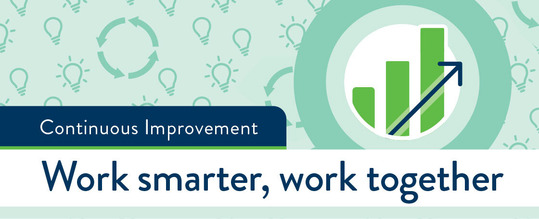
Learning and networking opportunities are available to all Minnesota DNR and MNIT at DNR employees through our agency membership with the Performance Excellence Network.
The DNR’s membership includes free access to one-hour bi-weekly online professional development seminars to support staff development in improvement methods and innovation. DNR Continuous Improvement staff host a debrief session on Teams following each seminar for Minnesota DNR employees to network and discuss application to our work. Our employees are also eligible for a discount on day-long workshops and conferences offered by PEN.
-
Request to join the Minnesota DNR Continuous Improvement group on Microsoft Teams to receive notifications and registration details of seminars and other continuous improvement learning opportunities.
- The next seminar, titled Unleashing the Strategic Mindset: Building More Proactive and Responsive Teams is Oct. 19.
- Recordings are available in the on-demand library. Past seminars have focused on: effective communication in changing work environments, managing change, best practices in managing a team, increasing resiliency under stress, and mitigating unconscious bias.
Contact Laura Grunloh or Yengmy Thao with any questions or visit the Continuous Improvement Intranet webpage to learn more about continuous improvement at the Minnesota DNR.
Make a pledge in Self-Service to support charities

October marks the Combined Charities campaign, an annual drive asking state of Minnesota employees to make a recurring payroll deduction in Self-Service and help support vital health, education, environmental, arts, and social service programs throughout the state.
Our goal for this month is to get 5% of Minnesota DNR employees to make these payroll deductions. The payroll deductions are a convenient way to directly donate to charitable federations, affiliated charities and 501(c) (3) charities of your choice and support causes you care about.
Even if you made a deduction last year, these deductions are only valid for a single calendar year. Any payroll deduction will begin in January and run through December.
To set up new or edit existing deductions:
- Go to the Self-Service portal (state.mn.us/employee.) and log in
- Select “My Pay"
- Select “Charitable Deductions.” From this page, you can review, add, or update voluntary deduction information
For more information and to learn more about participating federations, head to the state of Minnesota Combined Charities website. If you have questions, reach out to Ashley Kastner.

Wireside Chats: Sept. 26, 2023

Commissioner Sarah Strommen, Deputy Commissioner Barb Naramore, Tribal Relations Director Bradley Harrington and Learning and Development Manager Sheila Moore joined the Sept. 26 Wireside Chats to discuss the agency's tribal relations work and Work EVO.
To watch previous Wireside Chats, including both of the Sept. 26 editions, head to the Commissioner's Wireside Chats Intranet page.
Vikki Olsen awarded Bronze Smokey Bear award
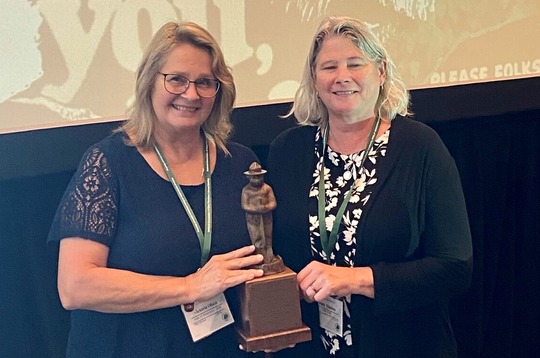 Office and Administrative Specialist Vikki Olsen (left) and Forestry Director Patty Thielen (right).
Vikki Olsen, an office and administrative specialist with the Forestry Division in Cambridge, was presented with a Bronze Smokey Bear award at the National Association of State Foresters annual meeting on Sept. 20.
The bronze award is the highest honor given to organizations or individuals for outstanding wildfire prevention service impacting a state over at least a two-year period.
Olsen was selected for her work to bring wildfire prevention to thousands of Minnesotans with "drive-by" events during the pandemic and organizing events to reach schools, fire departments, community organizations, law enforcement and emergency management.
"Her leadership has allowed the agency to reach a larger and broader audience across an area of high-risk wildfire communities," according to the Cooperative Forest Fire Prevention Committee. "Her work has become a model for the entire agency on how to develop an effective wildfire prevention outreach program."
Congratulations, Vikki!
MNIT Service Desk Support hub coming soon
MNIT is streamlining the help desk process to provide fast support for Minnesota DNR employees. MNIT will stop accepting emails at MNITServices.dnr@state.mn.us and will use the Minnesota HUB online web application and help desk phone line for all IT support requests starting Oct. 19.
How to get help
MNIT experts are equipped to fix technical issues, install hardware or software, and resolve your IT issues. You can reach them 24 hours a day, seven days a week online or by phone.
For more information, visit the service desk resources webpage.

Lost firearms, return litter to sender, and more
With multiple hunting seasons in full swing, conservation officers have been busy in the field. There are still plenty of people on the water, too, and COs are working to ensure they’re safe, following the rules, and not spreading aquatic invasive species.
The following are highlights from the weekly Conservation Office reports.
Aug. 25
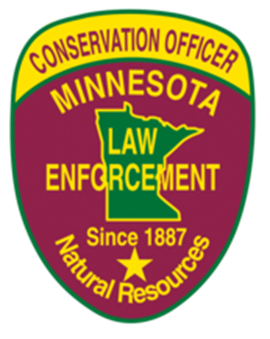
CO Nicholas Prachar (Blackduck North) took enforcement action for expired registration on an ATV, transporting a loaded firearm, hunting while intoxicated, and operating an ATV under the influence of alcohol. During the stop hunting while intoxicated stop, the person was so intoxicated that they lost their own firearm. Prachar located it a short time later in the road ditch.
CO Felicia Znajda (Osakis) spent her week at the Minnesota Law Enforcement Memorial Association Honor Guard camp, where she learned a wide range of Honor Guard skills. With these skills, she will be able to help the families and home agencies of law enforcement officers who have died in the line of duty. Znajda also shared a special moment with a father and son. The son had a goal to identify and bag a specific species, which he did.
CO Nicholas Klehr (Litchfield) spent time at Camp Ripley for annual in-service training. He also took enforcement action for failure to have all the correct licenses and stamps. Hunters who were missing required licenses or stamps all had similar explanations in which they said they told the clerk they wanted to go waterfowl hunting and just accepted whatever licenses they were given without checking them.
|
Aug. 18
CO Dan Starr (Onamia) worked on some bear season items related to baiting and carrying firearms with permits from other states. A bear had to be dispatched in Mille Lacs Kathio State Park for tearing down two tents and showing no fear of humans.
CO Clint Fitzgerald (Buffalo) identified a suspect who littered on a wildlife management area because they left a box with a shipping label still attached. The suspect was interviewed and enforcement action was taken.
Reminder: join the new parents group

Mark your calendars to attend the first New Parents Group meeting on Oct. 12 from noon to 1 p.m. This sub-team of the Well-being Action Team will bring together Minnesota DNR staff who are expecting or have recently become parents.
During the meeting you can provide feedback about what topics or information would be helpful to you, hear a presentation about the concept of “total responsibility transfer,” and connect with other new or expecting parents. The meeting invite was sent to all staff on Sept. 21. If you do not have the meeting invite, send an email to gratia.joice@state.mn.us to receive a link.
For more information, visit the Well-being Intranet webpage.
Accounts Payable reminders

Four new staff members have recently joined the Accounts Payable team. You might receive communication from them as they work on their training and learn the Minnesota DNR accounts payable process.
Welcome to Accounts Payable!
- Terri (Teresa) Anderson
- Wendy Johnson
- Kayley Schoonmaker
- Jen (Jennifer) Schreiber
Invoices
If you receive a returned invoice from Accounts Payable, the returned invoice needs to be addressed as a priority and proper action taken to resolve the issue (unless the invoice is a duplicate).
Employee business expenses
For meal allowances, refer to your bargaining unit contract or plan. Only AFSCME and MAPE bargaining units have updated effective dates — Aug. 16, 2023 and Aug. 19, 2023, respectively. The other bargaining unit contracts or plans are still in negotiations and not yet resolved. For more information, read the Expense Allowance by Bargaining Unit August 2023 document found on the Accounts Payable Intranet webpage.
There are very few exceptions for a paper copy of an expense form being accepted. It should be the most current paper version, easily identifiable by the column headings highlighted in yellow. The only staff that should be using a paper version of the expense form are those with a Mac computer or interns without access to computers. Reach out to Accounts Payable if a paper copy of an expense form is needed.
All other staff should be using the electronic version of the expense form, which has column headings highlighted in green. DNR Expense Form Installation Intructions can be found on the Accounts Payable Intranet webpage. Be sure to download the most recent version of the DNR Expense Form, which can be found in the Software Center.
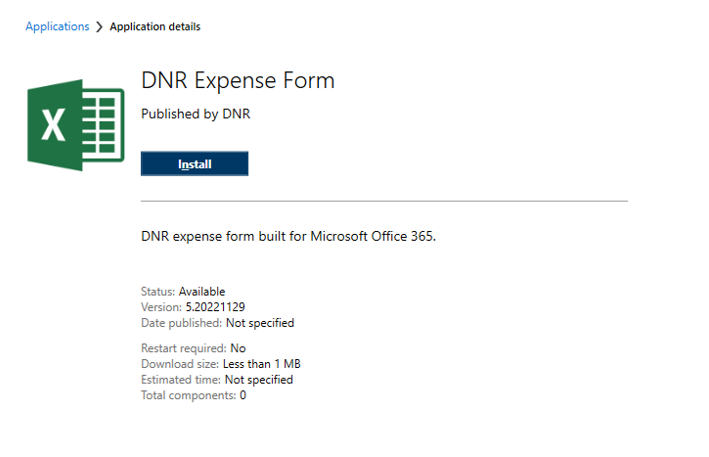 Purchasing cards
Follow the DNR P-cardholder and Supervisor Checklist instructions from the DNR EIOR System on the Intranet for preparing, processing, and submitting purchasing card logs.
Packet must include the following (in this order):
- Cardholder purchasing log
- Sales tax not paid on purchasing card
- P-card reimbursement sheet
- U.S. Bank statement
- Original receipts and packing slips (in order listed on statement)
- Other pertinent documents such as: special expense form, out-of-state travel form with agenda, statement of no receipt
For more information, visit the Accounts Payable Intranet webpage.

Area Wildlife Manager Kyle Arola
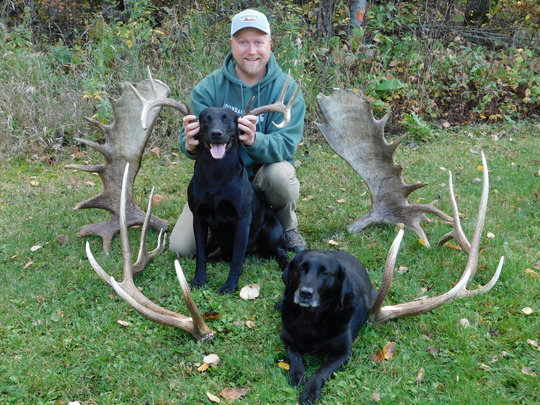 Determination and networking can open doors
By Morgan Sussman, Fish and Wildlife information coordinator
On Kyle Arola’s first day of ornithology class, his professor instructed everyone to look at the person on their right, then their left… and said only one of them would have a shot at getting into the wildlife field.
Kyle was determined to be one of those few.
His journey started with an aquatic focus. Kyle’s experience canoeing in the Boundary Waters landed him work with aquatic plants across the Midwest. His love of the outdoors led him to pursue a bachelor’s at St. Cloud State University in Ecology & Field Biology and continue to volunteer during the school year. His volunteering experience with the Minnesota DNR, working a Chronic Wasting Disease check station and later helping out the Sauk Rapids area wildlife office, solidified his course.
“It was at that point I realized this is what I would love to do,” Kyle said. “There’s a lot of variety [working at an area wildlife office].”
While Kyle was working as an interpretive naturalist at Mille Lacs Kathio State Park, the DNR posted two full-time shallow lake positions. He applied to both and didn’t get an interview.
“At that point, I went back to my network and asked if I should graduate with my bachelor’s and go off to get more seasonal experience or go right into a master’s program,” Kyle said, adding that he was disappointed but still determined.
With the relationships he had at Mille Lacs Kathio, he put together a master’s project on white pine restoration at the park. He was able to intern another summer as an interpretive naturalist while working on his research. Nearly two years later, he was well on his way to being ready for a second shot.
“Spring 2013 was wild,” Kyle said. “I was two classes shy of qualifying for DNR Fisheries. I got hired at Three Rivers Park District, working two days a week. Two days were dedicated to fisheries classes up at Central Lakes College, 20 hours a week with the graduate assistantship, and I was finishing out final courses at St. Cloud State for my master’s. There weren’t a lot of wildlife jobs open at the time, but I was hearing rumors about assistant wildlife area manager jobs coming open soon from my DNR contacts.”
That summer was when the DNR hired what some area wildlife staff know as “The Big 10.” He applied for all 10 area wildlife manager positions and made it into the narrow pool of applicants who got in-person interviews.
“I remember exactly where I was when I got the call,” Kyle said. “I was right by the Rogers exit coming back from Three Rivers Park District when Joel Huener, the Thief Lake wildlife area manager at the time, offered me the position as assistant. I accepted immediately.”
Fast forward 10 years and Kyle now serves as the area wildlife manager. He took over for Joel when he retired in 2018 and loves the variability of the job. The calling he experienced at Sauk Rapids is now a reality at Thief Lake.
“It’s never the same work month to month or day to day,” Kyle said.
Job duties at Thief Lake range from managing spring flooding to surveying sharp-tailed grouse leks and coordinating habitat improvement efforts with partner organizations. Kyle’s favorite is being up in a plane for survey work, counting elk and waterfowl.
His networking never stopped just because he landed the job – he now employs it to get the work done with other conservation organizations and agencies. While the most challenging part of his job is the daily disruptions from a more interconnected world – Teams messages and email threads – it also creates an opportunity to connect with others more easily in the field.
“We’re all working towards the same thing – healthy habitat and wildlife populations,” Kyle said. “I can’t say enough how much our partners help us get done. They apply for Conservation Partners Legacy dollars, we help coordinate the projects when they get the funding, and everyone benefits. We can’t do it alone.”
 Work site: Thief Lake Wildlife Management Area
Years at DNR: 10 years
Prior experience: Assistant wildlife area manager at Thief Lake WMA; seasonal wildlife aide at Three Rivers Park District; interpretive naturalist at Mille Lacs Kathio State Park
Education: Associate of Arts from Mesabi Community College, Bachelor’s and Master’s of Science from St. Cloud State University
Family: Two black labs, Isla Saskatoon and Peat Smoke. The name saskatoon came from an experience with her as a puppy eating juneberries – another name common name for juneberries are saskatoon berries. Peat Smoke was the name of a newsletter from the Conservation Career Corps camp back in the 1930s.
Something coworkers might not know: Kyle is a self-proclaimed shed hunting nut – he found a matching set of white-tail, elk, and moose antlers all within Minnesota last spring. He shares his shed hunting journeys and other outdoor adventures on his YouTube channel: @WildernessEnthusiast4307.

Fungus among us
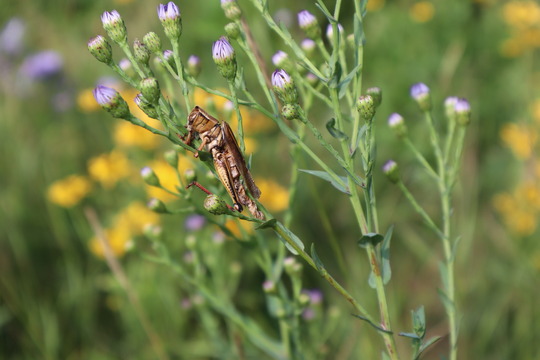 Photo credit: Michaela Rice, Interpretive Naturalist at Gooseberry Falls and Split Rock Lighthouse state parks.
Entomophaga grylli, or the summit fungus, causes an infected grasshopper to climb to the top of vegetation. The grasshoppers clasp their legs around the plant, point their heads upward and die. After the grasshopper dies, the fungus erupts from the body cavity, spreading its spores under the grass canopy.
After the insect cadaver falls to the ground, the spores overwinter in the soil and germinate in the spring, infecting more grasshoppers.
|